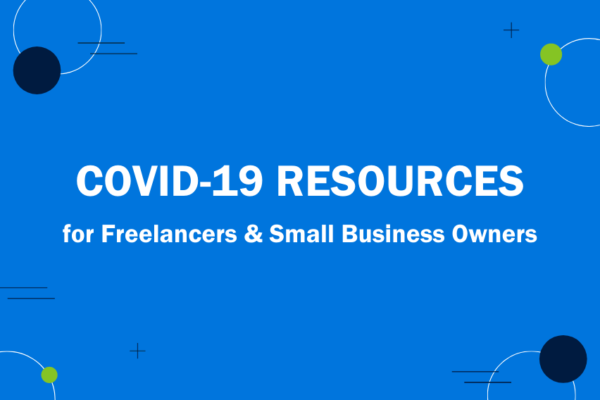How to get creative, find new revenue streams, and diversify your income.

There’s no denying that the coronavirus is changing the way we work. As a result of COVID-19, small businesses are having to rethink the way they connect with their customers—and, in many cases, rethink the way they do business altogether. But the current climate does offer an opportunity to look at new and different ways to drive revenue for your business. If you’ve never thought about diversifying your income, now is a great time to start.
But how, exactly, do you create multiple income streams for your business? What opportunities are available? And how do you get started diversifying your income (and creating a financial safety net in the process)?
Table of Contents
Why Diversifying Your Income Is Important
First things first. Before we jump into how to diversify your income, let’s quickly touch on why diversifying your income is so important in the first place—straight from entrepreneurs who’ve diversified themselves.
Diversifying your income drives revenue from multiple areas of your business, which helps you:
- Avoid being completely reliant on any single income stream
- Create a safety net should one of those income streams dry up
- Provide new opportunities to broaden your business, connect with new clients, and explore new opportunities
Diversifying your income also offers the opportunity to change things up and look at your business in a new way.
Essentially, when you diversify your income, you get the opportunity to get creative and find new and different ways to drive revenue in your business. And the more revenue streams you have flowing into your business, the more you’re protected if any single revenue stream is no longer profitable—which protects your business (and your finances) as a whole.
“I have my own business. If I don’t get the money in, the refrigerator is empty,” says Sandy van Thol, a tax attorney based in Aruba who recently diversified her income through business consulting and teaching online yoga classes. “So [diversifying my income] gave me more peace of mind. Everything is still flowing and I do believe that the moment you set your mind to ‘okay, we’re going to make this happen,’ you’re creating opportunity and grabbing possibilities.”
Clearly, diversifying your income is important. But how, exactly, do you do that?
Strategy #1: Take Your Physical Sales to the Digital Space
Brick-and-mortar retail locations have been hit hard by the coronavirus. Most people aren’t shopping for non-essentials in person—and, in much of the world, retail locations have been ordered to close their doors.
But the fact that people aren’t shopping at your store offers the perfect opportunity to move your sales to the digital space.
Julie Williams is a visual and verbal storyteller specializing in event and portrait photography. Due to coronavirus-related restrictions on non-essential businesses, her photography business has come to a standstill. But she used the slowdown as an opportunity to explore other ways to drive income, including selling products online, like wall art and matted prints.
“[Taking steps to diversify my income] has been a great opportunity to think creatively to offer new products to my clients through a different channel that will be more far-reaching through the internet,” says Williams. “The ‘downtime’ has been the motivation and opportunity to free up time to explore launching my e-commerce site and, in the process, connecting with other businesses and the potential for future collaborations.”
If you’re not already selling your physical products online, now is a great time to explore e-commerce. Use a platform like Shopify or Squarespace to set up your own e-commerce shop. Start selling your products on a digital marketplace (like Etsy). Make your products available online so your customers can continue to engage your business from the comfort (and safety!) of their own home.
Not only will investing in e-commerce pay off in a big way now, but offering your customers another way to purchase your products can continue to drive revenue long after the pandemic is over.
Strategy #2: Leverage Your Expertise to Build a Digital Products Business
It doesn’t matter what kind of business you run or what kind of skills or expertise you have; there are people out there who want to learn about that business type or develop those skills. So why not be the one to teach them?
Digital products can be a great way to diversify your income and develop additional revenue streams. And the best part? Digital products can be passive income (or, in other words, they’ll continue to drive revenue long after you’ve actually put in the work of creating the product).
There is a huge variety of digital products and content you can create to share your expertise, including:
- ebooks
- Worksheets or checklists
- Templates
- Online courses or webinars
- Educational videos
If you’re a business owner, you also have two different routes you can take when building your digital products. You can:
- Build a product around your area of expertise (e.g., if you’re a photographer, you could create an online course on photography)
- Use your experience as a business owner to launch digital products targeted toward new or budding entrepreneurs (e.g., a video series on how to effectively interview potential employees or an ebook on the steps entrepreneurs need to take to launch a new venture)
Digital products give you a chance to share your knowledge and help others who are interested in your skills, expertise, and business—and diversify your income at the same time.
Strategy #3: Try Your Hand at Consulting
One of the most common (and potentially lucrative) ways to build off your business and develop additional income streams? Consulting.
No matter which industry, area, or niche you specialize in, look for opportunities to offer consulting services to both individuals and other businesses.
For example, let’s say you own a human resources firm. You could consult with job seekers on their resume design and interviewing skills, and consult with businesses to help them develop a plan for rehiring employees who were laid off due to the coronavirus.
Or let’s say you own a restaurant. You could consult with other restaurants in the area to help them develop a delivery and takeout plan to keep their businesses up and running while their doors are shuttered.
The point is, as a business owner, you have the expertise necessary to consult in your industry—so use that expertise to diversify your income.
Strategy #4: Let Go of Previous Client Requirements
Typically, freelancers have a niche. Maybe you work with a specific kind of client or on a specific type of project.
But in order to diversify your income, it’s important to stay open to opportunities that might fall outside of your comfort zone.
If you want to develop multiple income streams for your business, it’s important to let go of your ideas of the “perfect” type of work or the “perfect” client. Sometimes, the best opportunities to diversify your income are outside your typical “bread and butter” assignments, or outside of your typical freelance scope entirely.
Take Patrick Icasas, for example. Icasas runs his own freelance writing and content marketing business. And while writing is the primary focus of his business, he realized that diversifying his income might mean thinking outside of the box and exploring options outside the writing world.
Today, Icasas has multiple streams of income outside of his writing business, including a day job in customer success, and running a strategic agency that works with early-stage start-ups.
“In light of the current situation, I’m really glad that I’ve [diversified my income]. Because my day job cut back on the number of hours that people are working, so I’m working four days a week instead of five days a week,” says Icasas. “But fortunately, that just gives me more time to work on the freelance and the agency stuff.”
The point is, that being too narrow-minded about the kinds of freelance jobs and assignments you’ll take on limits your opportunities. So, if you really want to diversify your income, it’s important to stay open to all opportunities—even if they fall outside of the scope of your “typical” or “ideal” job.
Strategy #5: Look for Untapped Resources in Your Industry
No matter what industry you’re in, you probably specialize in something specific. You might be a wedding photographer, own a branding agency, or run a local coffee shop.
If your area of specialty is being hit hard by the coronavirus, you can find ways to diversify your income within your industry. You just have to get creative, think outside of the box, and look for new and unexpected ways to drive income.
For example:
- If you’re a wedding photographer, you might consider selling stock photos
- If your branding agency is seeing a slowdown with clients, you can start selling logos and other brand designs on digital marketplaces like 99designs
- If your coffee shop is under a non-essential business shutdown, you can bag your coffee beans, partner with other local businesses who have been affected, and put together “care packages” to sell to your customers
There are multiple revenue opportunities within every industry—and if you want to diversify your income, you need to get creative and find (or make!) those opportunities.
Strategy #6: Turn to Social Media
Have you built a large social media following, either for yourself or for your business? If so, social media could offer a variety of opportunities to diversify your income.
There are a ton of different ways to monetize your social media presence—and the more followers, the more income potential.
Some of the ways you can monetize a large social media following include:
- Brand partnerships. Brands partner with social media influencers as a way to get their products in front of potential customers—and often pay well to do so. (And there’s no need to be a Kylie Jenner-level influencer in order to get paid brand sponsorship; “micro-influencers”—or influencers with small but engaged audiences—can be just as attractive to brands.)
- Affiliate marketing. Affiliate marketing is all about promoting other services and products. When someone in your audience purchases a service or product you’re promoting, that company then pays you a commission. The more purchases you drive, the more you make in commissions.
- Ad revenue. If you have a YouTube channel, you can monetize your videos with ads.
- Paid content. Creating paid content for social media is another opportunity to monetize your platform of choice. For example, you might start a Facebook group where you share premium content—and charge followers a subscription fee to gain access.
Strategy #7: Look for Ways to Offer Value for Free
It might sound counterintuitive, but one of the best ways to drive additional revenue for your business is to offer value for free.
Offering real value to your community for free (obviously) doesn’t drive immediate revenue. But it does accomplish a number of other goals that can help drive more sales and cash into your business.
First, offering value shows your audience that you’re invested in them. It helps to build trust and buy-in, which can help to transform prospects into customers and one-time customers into long-term customers.
Creating value can also help you establish yourself and your business as a thought leader in your space. This can help to increase your reach and build your reputation—both of which will help you get in front of more customers.
Look for ways to offer value to your community and customers, whether that’s in the form of a free webinar, a live Q and A, or an information-packed ebook. Then, offer that value in exchange for their email address so you can keep in touch, keep your business top of mind, and continue to market to them in the future.
This is a more long-term strategy for diversifying your revenue—but if you put the time and effort into offering value for free now, it can definitely pay off later.
4 Tips for Successfully Building and Managing Multiple Income Streams
Looking for more insights on how to effectively build and manage multiple income streams? Here are a few tips from the entrepreneurs we spoke to:
1. Tap Into Your Existing Client Base
Your existing clients and customers already bring revenue into your business when they buy your products and services. But they could also offer other opportunities to diversify your income.
“One of my current day jobs is customer success at a software company, and that’s been going on for about four or five years now, which is interesting because they used to be…my freelance writing client,” says Icasas.
Think of ways your existing clients or customers could provide other revenue streams. For example, your customers might be used to buying your products—but they might also be interested in engaging you for a consulting opportunity.
2. Don’t Be Afraid to Try New Things
When you think of diversifying your income, you’re probably thinking of ways to capitalize on what you’re already doing. But don’t be afraid to think outside of the box!
“You shouldn’t limit yourself to what you think your primary skill is,” says Icasas. “Try something new. Try something different. It might turn out to be much better than your original.”
If there’s a skill you have—or a skill you want to develop—have a go at trying to turn it into an additional revenue stream. So, for example, maybe you run a restaurant—but you’ve always had a knack for writing. Try exploring some freelance writing gigs and see where it goes.
The point is, when you’re diversifying your income, you can be as diverse as you want to be. So don’t be afraid to try something new!
3. Cut Yourself Some Slack
Diversifying your income and developing multiple revenue streams is going to take some trial and error. Some things will work great and some things…not so much.
That’s why it’s so important to cut yourself a little slack.
“You’re going to mess up somewhere because it’s going to be new,” says van Thol. “If you make a mistake, learn from it—and then move on. Don’t dwell on it or beat yourself up.”
Trying new things can be tough. So if you’re trying to develop new income streams for your business, make sure to cut yourself some slack.
4. Keep Your Revenue Streams Organized
The more diverse your income streams, the more there is to manage—and the more important it is to stay organized.
“You need to be highly organized and efficient with your time and have a system in place that works for keeping track of your tasks, events, and deadlines,” says Williams.
Make sure you have the right tools and systems in place to manage your multiple revenue streams. Use tools like Google Calendar and Calendy to keep track of your daily to-dos and appointments.
Use FreshBooks to organize your income, process payments, and categorize your invoices. Get a system in place so you know what you’re working on, when you’re working on it, and what kind of income it’s bringing into your business.
The more organized you are, the easier it will be to manage multiple revenue streams—and the more you can diversify your income as a result.
Diversify Your Income and Protect Your Finances
Diversifying your income has a variety of benefits. It creates a financial safety net that can help you and your business power through tough times, open you up to new opportunities, and help you explore new skills and talents. Now that you know the strategies you’ll need to start building new revenue streams, all that’s left to do? Get out there and diversify your income!

Written by Deanna deBara, Freelance Contributor
Posted on April 14, 2020

 How Small Business Owners Can Prepare for a Recession
How Small Business Owners Can Prepare for a Recession Managing Your Business During Uncertain Times
Managing Your Business During Uncertain Times COVID-19 Resources for Freelancers and Small Business Owners
COVID-19 Resources for Freelancers and Small Business Owners
 Roundup: Does it Ever Make Sense to Work For Free?
Roundup: Does it Ever Make Sense to Work For Free?![Crack the Client Code: How to Discover the Hidden Wealth in Each Client [Free eBook] cover image](https://prod-blog-k8s.freshenv.com/blog/wp-content/uploads/2020/05/Crack_client_code_blog_Post_Image-e1618594341993-600x400.jpg) Crack the Client Code: How to Discover the Hidden Wealth in Each Client [Free eBook]
Crack the Client Code: How to Discover the Hidden Wealth in Each Client [Free eBook] Finding Clients in Today’s Economy
Finding Clients in Today’s Economy
![Standing Out From the Crowd [Free eBook] cover image](https://prod-blog-k8s.freshenv.com/blog/wp-content/uploads/2022/05/Standing-Out-From-the-Crowd_eBook-Blog-Hero-Image-226x150.png)




